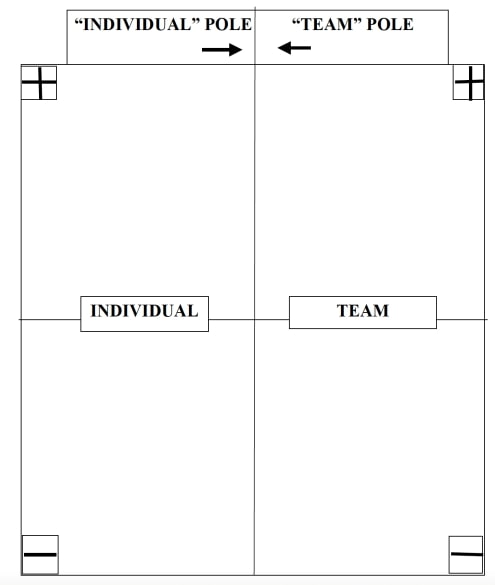Since the dawn of time, philosophers have been interested in exploring contradictions and paradoxes, so much so that Aristotle in his Metaphysics enunciated the “Principle of Non-Contradiction” (one thing cannot be and not-be at the same time) as the basis for human rational thinking. In modern philosophy this principle is being discussed at length and the debates continue to these days, with, needless to say, contradictory opinions.
Stepping down a notch, in our every-day life, we all have probably experienced contradictory feelings, or have adopted behaviors that were the opposite of our wishes, or felt pulled in many different directions. All these tendencies and manifestations can be defined as “paradoxical”, if we look at life as a black-and-white experience. But the truth is that life is a Technicolor adventure and nobody sees exactly the same colors.
Contradictions and paradoxes entail mutual exclusion. If a trait is present, the opposite trait is most likely missing. If we are impulsive, we can’t be patient – if we are analytical, we can’t be imaginative and creative – if we are outgoing and extroverted, we can’t be shy…or can we?
Thinking of ourselves as defined, unidirectional beings may bring about unwanted consequences, such as suppressing parts of ourselves, or over-identifying with some traits, greatly limiting our possibilities and growth. It may feel reassuring to have a consistent view of ourselves and society encourages us (or at least has done so until now) to paint our portrait fair and square for the sake of a simplified, business-functional reality, but this black&white view generates an innate tension and a feeling of wrongness every time something doesn’t fit with our pre-fabricated mold.
These dynamics become even more complex in our work environment, since they sends us contradictory messages on how we should fulfill our role in the company, how we should work and relate to our colleagues, bosses and reports. It’s not easy to navigate this interesting, but very complex, era, especially if we are used to a more fixed work structure (ref. our previous newsletter “Different Generations in the Workplace”).
Paradoxical Messages in the Workplace: From Problem Solving to Polarities Management[1]
Anne is a very successful executive, but she has a dilemma that is consuming a very large part of the energy she should be dedicating to her actual duties. Her company’s HQ are based in France, but her branch office is in New York. She is told to follow policies and directives coming from the HQ and deliver the best results. Unfortunately, these guidelines and constraints hardly apply to the cultural dynamics of her branch office, slowing down achievements and affecting her performance negatively, causing her to spend a lot of time and brain cells in figuring out a way of overcoming this opposite pull.
Just like Anne, in our professional life we encounter a multitude of paradoxical messages, apparently needing to be addressed by contradictory action plans. These challenges fuel a great deal of stress, especially because they must be usually solved within a very constrained timeframe and budget, along with an already heavy workload and little margin for error.
When growing stress enters the picture, we very often stop seeing all the colors and we go into an either/or, on-off mode, considering only mutually exclusive solutions to the problem and adopting a “problem-solving” approach.
But when a contradiction occurs, and we have to step into action, it’s useful to consider the difference between “a problem to solve” and “management of polarities or paradoxes” in order to adopt the right strategy:
- A “problem to solve” is when you have one thing that caused something else and you need to fix it.
- “Polarity management or paradox” is when you need to balance the two sides of a polarity in order to be effective.
Going back to Anne, she could choose to strictly follow her HQ directives over adapting and playing with the dynamics of her foreign branch office, or the opposite. But any of these radical stands won’t lead to the best outcome: a balance and synergy between the two ways of working, which will bring the optimal results.
The mistake we may inadvertently make is to solve polarity management issues with a problem-solving mindset, completely eliminating one end of the problem. But if Anne should rigidly adhere to her HQ guidelines for example, she would end up enhancing the resistance of her actual work environment in NY, and she would unknowingly participate in building up a wall that would isolate her from the reality of her local work dynamics. She would lose support and collaboration, and her performance would become increasingly poor, so that the HQ would eventually be very disappointed and doubt her value as a manager. She would find herself in a lose/lose scenario.
On the contrary, if we focus on polarity management, we will work towards a synergetic blend of the two strategies. All voices will be heard, and a common solution will be found.
| Problem to Solve | Polarities to manage |
| They are not ongoing. There is an endpoint. They are solvable. |
They are ongoing. There is no endpoint. They are not solvable. They must be managed together. |
| Independent Alternatives. | Interdependent Alternatives |
| They can stand alone. There is no need to include an alternative for the solution to work. |
They cannot stand alone. The alternatives need each other to optimize the situation, over time. |
| Often contain mutually exclusive opposites. | Always contain mutually inclusive opposites. |
| · Should we promote Bill? · What should we include in our customer survey? · Should we buy the 200 ton press? · Should we remove one level of management ? |
· Recognize the individual & recognize the team · Reduce cost & improve quality · Competing with others & collaborating with others · Work commitments & home commitments |
Expanding the View

Looking at this image, if you say, “this is a picture of a goblet”, you’re accurate, but not entirely. Same if you say “this is a picture of two faces”. The incompleteness, combined with the conviction of the accuracy of our own perception, is the source of potential problems. Each person’s view in fact, is confirmed as accurate, but needs to be completed with the other perspectives in order to see the whole picture. In this case, each viewpoint has key pieces to the puzzle and contradiction becomes a resource.
Yet, in our organizations, there are often very serious and costly confrontations that take place because paradoxes are treated as a problem to solve. Polarity Management can help us in our daily challenges in the workplace when we have opposite positions that we need to integrate, to manage change, and to navigate complexity by expanding our vision to see the forest AND the tree.
To have a broader view on a certain issue we can start by:
- Letting go to get more
The goblet and the two faces cannot be seen at the same time. Either one or the other stands out and is clear. Though you can shuttle back and forth quickly, to see the goblet sharply requires your letting go of the two heads. Letting go doesn’t mean that if you let go of the focus on something, you either lose it or it is no longer in the picture. It means that you ALSO need to look at the other image. In other words, one truth doesn’t negate another truth. You just need resources beyond your two eyes to embrace all of them at the same time.
- Start where you have power
Start expanding your own view, in order to include other people’s. The only true power you have is on your own mind, and the openness and inclusiveness will encourage other people to do the same, weakening their resistance to your viewpoint, as they feel theirs is accepted as well. Lead by example.
A Tool for Polarity Management
This simple scheme with 4 quadrants is a very useful tool to get the best from polarities. Let’s take the example of Team work/Individual work.

The right and left halves are called poles.
The upper part of each pole contains the positive aspects of that pole or its “upsides”.
The lower part of each pole contains the negative aspects of that pole or its “downsides”.
There is no correct order for filling out the quadrants, you just need to complete all of them to have the full picture on your issue. Here’s a suggested pathway:
- Identify a key polarity through dialogue, to create a non-blaming description of the issue and to individuate opportunities and disagreements present in any given situation.
- Agree on names for the poles and write them in the map. Remember both poles are necessary and interdependent.
- Brainstorm together the content for each quadrant. Aim for four to eight entries in each quadrant. Identify upsides and downsides for both poles. Oppositional values and fears get identified and are respected as important.
- Agree on a higher purpose and deeper fear. Agreeing on a higher purpose integrates opposite views and provides a reason to manage the tension between the two views.
Some useful tips:
- Remember that to pursue the benefits of one pole, you must also pursue the benefits of the other pole. The solution is not static.
- Listen deeply and facilitate dialogue, especially when some group members resist accepting the others’ view. Value feedback and promote openness, creating a safe environment where everybody can express his view because he/she knows it will be considered and respected.
- Brainstorm strategies for staying in the upside of both poles.
- Stay away from the “One Pole Myth”. You may be tempted to stay in one polarity because it’s the one that brought you good results until now. But if you stay just on one pole, you’ll end up getting the downsides of both poles, while losing the benefits. The paradox is that those who are deeply afraid of the downside, end up experiencing it if they don’t integrate the aspects of the opposite polarity.
To get the best from polarities, they need to actively communicate and permeate each other. So, if you encounter a wall of resistance, try to break it down and make it a bridge. The easiest way to do so is to start by getting a clear perception of others’ reality, rather than trying to convince them of yours.
Conclusion
We saw how polarity management can help us understand and create richness and growth from opposite stands in the workplace. But what if we could apply the same approach to the highly difficult, delicate themes that we are facing every day?
How could discussions around gender, ethnicity, politics, relationships be enriched by an approach that is not based on the opposition to the other’s point of view – creating an extreme divide very hard to fill and burning the bridges – but instead is founded on listening and on searching for understanding? We can be guided by the belief that it is possible to find value in what’s different, and get closer to a stand where we can at least work together in the respect of one another. Get to a scenario where we are fellow humans and not enemies.
And at the same time, how much would we gain from NOT running to the opposite extreme every time a delicate matter is brought to attention and needs to be managed? If you look around and observe, every day we are caged in a mechanism of “that’s wrong – fix it”, rushing to the opposite polarity for a quick, anxiety-driven, easy solution, hence increasing extremism in both parties. Why are we in such a hurry to suppress the conflict? Why are we so scared by it? Wouldn’t a calmer pace, an open approach where everybody can talk freely – without establishing wrongs or rights, but just listening out – and a wise moderation of the conflictual situation bring a better outcome?
Conflict is a stage where we can learn and grow, where status quo gets torn apart and innovation begins, where we could be able to open the gate to different opportunities and possibilities. And believe it or not, we can take it and thrive within it, if we manage conflict correctly and resist the urge to cancel it immediately with a quick fix.
Let’s think about it. Maybe we don’t need to fix the conflict, but just to sustain it long enough to find a solution together.
[1] “Polarity Management: identifying and managing unsolvable problems”, Barry Johnson, ed. Human Resource Development, Pr, 2014.



